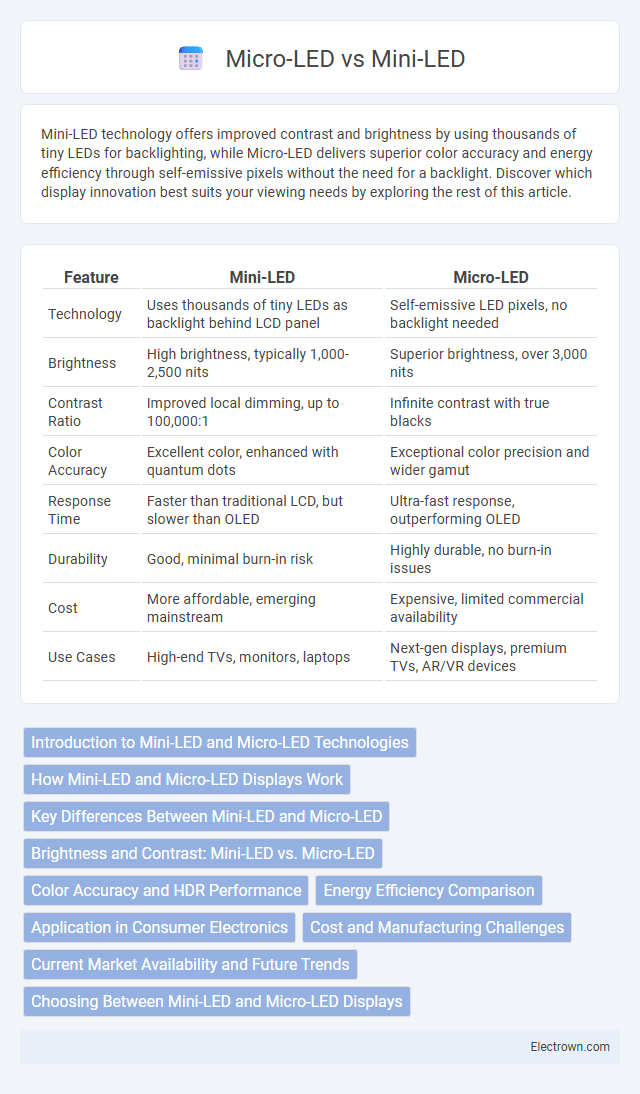Mini-LED technology offers improved contrast and brightness by using thousands of tiny LEDs for backlighting, while Micro-LED delivers superior color accuracy and energy efficiency through self-emissive pixels without the need for a backlight. Discover which display innovation best suits your viewing needs by exploring the rest of this article.
Table of Comparison
| Feature | Mini-LED | Micro-LED |
|---|---|---|
| Technology | Uses thousands of tiny LEDs as backlight behind LCD panel | Self-emissive LED pixels, no backlight needed |
| Brightness | High brightness, typically 1,000-2,500 nits | Superior brightness, over 3,000 nits |
| Contrast Ratio | Improved local dimming, up to 100,000:1 | Infinite contrast with true blacks |
| Color Accuracy | Excellent color, enhanced with quantum dots | Exceptional color precision and wider gamut |
| Response Time | Faster than traditional LCD, but slower than OLED | Ultra-fast response, outperforming OLED |
| Durability | Good, minimal burn-in risk | Highly durable, no burn-in issues |
| Cost | More affordable, emerging mainstream | Expensive, limited commercial availability |
| Use Cases | High-end TVs, monitors, laptops | Next-gen displays, premium TVs, AR/VR devices |
Introduction to Mini-LED and Micro-LED Technologies
Mini-LED technology utilizes thousands of tiny LEDs as backlights behind an LCD panel, enhancing brightness, contrast, and local dimming capabilities compared to traditional LED displays. Micro-LED features self-emissive pixels made up of microscopic LEDs that emit their own light, delivering superior color accuracy, higher brightness, and better energy efficiency without the need for a backlight. Both technologies represent significant advancements in display innovation, targeting improved visual performance in TVs, monitors, and mobile devices.
How Mini-LED and Micro-LED Displays Work
Mini-LED displays use thousands of tiny LEDs as a backlight behind an LCD panel, improving brightness and contrast by enabling localized dimming zones. Micro-LED technology consists of microscopic LEDs that act as individual pixels, emitting their own light and color without the need for backlighting, resulting in superior brightness, contrast, and energy efficiency. Your choice between Mini-LED and Micro-LED will impact display performance, power consumption, and overall visual experience.
Key Differences Between Mini-LED and Micro-LED
Mini-LED technology utilizes thousands of tiny LEDs as a backlight behind an LCD panel, offering improved brightness and contrast compared to traditional LCDs. Micro-LED, on the other hand, is a self-emissive display where each pixel is an individual microscopic LED, delivering superior color accuracy, higher brightness levels, and energy efficiency. The key differences lie in Mini-LED's backlighting approach versus Micro-LED's pixel-level illumination, resulting in distinct performance advantages in contrast ratio, viewing angles, and response times.
Brightness and Contrast: Mini-LED vs. Micro-LED
Micro-LED displays deliver superior brightness levels, often exceeding 5,000 nits, far surpassing Mini-LED panels, which typically reach around 1,000 to 2,000 nits. In terms of contrast, Micro-LEDs achieve near-infinite contrast ratios due to their self-emissive pixels that can turn off individually, eliminating blooming effects common in Mini-LED technology. Mini-LED relies on thousands of tiny LEDs backlighting an LCD panel, which improves contrast and black levels compared to standard LED but cannot match the pixel-level light control of Micro-LED.
Color Accuracy and HDR Performance
Mini-LED technology enhances HDR performance by increasing local dimming zones, resulting in brighter highlights and deeper blacks that improve overall contrast. Micro-LED offers superior color accuracy with individual self-emissive pixels capable of producing precise and rich hues without relying on backlighting. For your viewing experience, Micro-LED provides more vibrant colors and true HDR capabilities, while Mini-LED serves as a high-quality, cost-effective alternative.
Energy Efficiency Comparison
Mini-LED technology offers improved energy efficiency over traditional LCDs by utilizing localized dimming zones that reduce power consumption during darker scenes. Micro-LED displays surpass Mini-LED in energy efficiency, as each pixel emits its own light without backlighting, resulting in lower power usage and better contrast ratios. Your choice between the two should consider Micro-LED's superior energy savings alongside its current higher production costs and availability.
Application in Consumer Electronics
Mini-LED technology enhances backlighting in consumer electronics, offering improved contrast and brightness in devices like TVs, monitors, and laptops, while maintaining cost-effectiveness and compatibility with existing LCD panels. Micro-LED displays deliver superior image quality with self-emissive pixels, resulting in better color accuracy, higher brightness, and longer lifespan, making them ideal for premium smartphones, AR/VR devices, and large-format displays. Both technologies represent significant advancements in display innovation, with Mini-LED bridging current LCD improvements and Micro-LED setting the stage for next-generation screens.
Cost and Manufacturing Challenges
Mini-LED technology offers a cost-effective solution with relatively simpler manufacturing processes compared to Micro-LED, which involves intricate placement of millions of microscopic LEDs, driving up production expenses. Micro-LED displays deliver superior brightness and contrast but face significant challenges in mass production, including yield rates and alignment precision, resulting in higher retail prices. Understanding these factors helps you evaluate the trade-off between affordability and advanced performance when choosing next-generation display technology.
Current Market Availability and Future Trends
Mini-LED technology is currently more widely available in consumer products like TVs and laptops due to its lower production costs and established manufacturing processes. Micro-LED displays, offering superior brightness and energy efficiency, remain limited to high-end prototypes and niche markets because of complex mass-production challenges. Your next display upgrade may increasingly favor Micro-LED innovation as manufacturers overcome scalability issues, promising enhanced performance and durability in future markets.
Choosing Between Mini-LED and Micro-LED Displays
Choosing between Mini-LED and Micro-LED displays depends on factors like brightness, contrast, and price. Mini-LED technology offers enhanced backlighting with thousands of tiny LEDs, delivering improved contrast and HDR performance at a lower cost. Micro-LED provides superior brightness, infinite contrast, and longer lifespan due to self-emissive pixels, making it ideal for premium displays despite higher pricing.
Mini-LED vs Micro-LED Infographic

 electrown.com
electrown.com